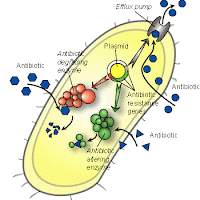Antibiotic (Greek anti, “against”; bios, “life”), chemical substance produced by one organism that is destructive to another. This process traditionally has been called antibiosis and is the opposite of symbiosis. More specifically, an antibiotic is a type of chemotherapeutic agent, that is, it has a toxic effect on certain types of disease-producing microorganisms without acting dangerously on the patient. Some chemotherapeutic agents differ from antibiotics only in that they are not secreted by microorganisms, as are antibiotics, but rather are made synthetically in a chemical laboratory. Examples are quinine, used against malaria; arsphenamine, used against syphilis; the sulfa drugs, used against a wide variety of diseases, notably pneumonia; and the quinolones, used against hospital-derived infections (zoonoses). A few antibiotics, among them penicillin and chloramphenicol, have now been produced synthetically also. Antibiotic
History of Antibiotic
The first observation of what would now be called an antibiotic effect was made in the 19th century by the French chemist Louis Pasteur, who discovered that certain saprophytic bacteria can kill anthrax germs. About 1900 the German bacteriologist Rudolf von Emmerich isolated a substance called pyocyanase, which can kill the germs of cholera and diphtheria in the test tube. It was not useful, however, in curing disease. In the 1920s the British bacteriologist Sir Alexander Fleming, who later discovered penicillin, found a substance called lysozyme in many of the secretions of the body, such as tears and sweat, and in certain other plant and animal substances. Lysozyme has strong antimicrobial activity, but mainly against harmless bacteria.
Penicillin, the archetype of antibiotics, was discovered by accident in 1928 by Fleming, who showed its effectiveness in laboratory cultures against many disease-producing bacteria, such as those that cause gonorrhea and certain types of meningitis and bacteremia (blood poisoning); however, he performed no experiments on animals or humans. Penicillin was first used on humans by the British scientists Sir Howard Florey and Ernst Chain during the 1940-41 winter.
The first antibiotic to be used in the treatment of human diseases was tyrothricin (one of the purified forms of which was called gramicidin), isolated from certain soil bacteria by the American bacteriologist René Dubos in 1939. This substance is too toxic for general use, but it is employed in the external treatment of certain infections. Other antibiotics produced by actinomycetes (filamentous and branching bacteria) occurring in soil have proved more successful. One of these, streptomycin, discovered in 1944 by the American microbiologist Selman Waksman and his associates, is effective against many diseases, including several in which penicillin is useless, especially tuberculosis.
Present Use of Antibiotic
Since then, such antibiotics as chloramphenicol, the tetracyclines, erythromycin, neomycin, nystatin, amphotericin, cephalosporins, and kanamycin have been developed and may be used in the treatment of infections caused by some bacteria, fungi, viruses, rickettsia, and other microorganisms. In clinical treatment of infections, the causative organism must be identified and the antibiotics to which it is sensitive must be determined in order to select an antibiotic with the greatest probability of killing the infecting organism.
Recent Developments of Antibiotic
Strains of bacteria have arisen that are resistant to commonly used antibiotics; for example, gonorrhea-causing bacteria that high doses of penicillin are not able to destroy may transfer this resistance to other bacteria by exchange of genetic structures called plasmids (see CONJUGATION). Some bacteria have become simultaneously resistant to two or more antibiotics by this mechanism. New antibiotics that circumvent this problem, such as the quinolones, are being developed. The cephalosporins, for instance, kill many of the same organisms that penicillin does, but they also kill strains of those bacteria that have become resistant to penicillin. Often the resistant organisms arise in hospitals, where antibiotics are used most often, especially to prevent infections from surgery.
Another problem in hospitals is that many old and very ill persons develop infections from organisms that are not pathogenic in healthy persons, such as the common intestinal bacterium Escherichia coli. New antibiotics have been synthesized to combat these organisms. Fungus infections have also become more common with the increasing use of chemotherapeutic agents to fight cancer, and more effective antifungal drugs are being sought.
The search for new antibiotics continues in general, as researchers examine soil molds for possible agents. Among those found in the 1980s, for example, are the monobactams, which may also prove useful against hospital infections. Antibiotics are found in other sources as well, such as the family of magainins discovered (in the late 1980s) in frogs; although untested in humans as yet, they hold broad possibilities.
Antibiotics have also been used effectively to foster growth in animals. Concern has arisen, however, that this widespread use of antibiotics in animal feed can foster the emergence of antibiotic-resistant organisms that may then be transmitted to human beings. An instance of one such transfer was documented in the United States in 1984.Antibiotic
by : Emil
Terima kasih untuk Like/comment FB :
